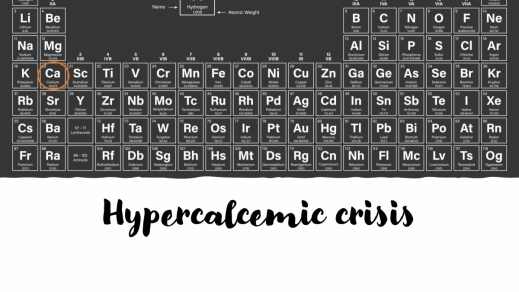Hypercalcemic crisis

A 52-year-old woman with a history of hypertension sustained a large left frontoparietal intracerebral hemorrhage resulting in right-sided flaccid paralysis complicated by acute respiratory failure status post tracheostomy for prolonged mechanical ventilation. She is transferred to the step-down intensive care unit for ventilator weaning. Serum calcium level returns elevated at 11.3 mg/dL with a serum albumin level of 2.8 g/dL. What is the most likely cause of her hypercalcemia and how should it be managed?
Calcium homeostasis
While hypercalcemic crisis with serum calcium level > 14 mg/dL is rare, hypercalcemia is a frequently encountered lab abnormality and should not be overlooked, particularly in the critically ill. Nearly 99 percent of total body calcium is stored in bone with only a small fraction present in the blood. Approximately half of total serum calcium is bound by albumin, so it is important to correct the total serum calcium for hypoalbuminemia, a condition commonly encountered in the critically ill. The patient referenced above has a corrected calcium of 12.3 mg/dL. Calcium concentrations are typically maintained in a narrow therapeutic range, but are perturbed by bone resorption or alteration of regulatory hormones, dietary intake and renal elimination. Bone resorption is enhanced in patients with elevated parathyroid hormone levels, as occurs in primary hyperparathyroidism. Additionally, patients in the ICU are frequently immobilized, which can also lead to bone resorption from lack of weight-bearing exercise.
Differential diagnosis
The most common cause of hypercalcemia is primary hyperparathyroidism where excessive parathyroid hormone (PTH) secretion leads to hypercalcemia via osteoclastic bone resorption. The vast majority of patients with primary hyperparathyroidism have elevated PTH due to a benign parathyroid adenoma; however, diffuse parathyroid hyperplasia or parathyroid carcinoma can also raise serum PTH levels. Malignancy-associated hypercalcemia is the next most common etiology caused by osteolysis from multiple bony metastases or humoral hypercalcemia of malignancy resulting from parathyroid hormone-related protein (PTH-RP) secretion. Other causes of hypercalcemia include granulomatous diseases like sarcoidosis or tuberculosis, hyperthyroidism, adrenal insufficiency, immobilization or medications, like thiazide diuretics, excess vitamin D or vitamin A, calcium and lithium. It is important to determine early whether hypercalcemia is dependent upon PTH secretion or a mechanism independent of parathyroid hormone through measurement of PTH, PTH-RP and 1,25-dihydroxy vitamin D levels.
Clinical manifestations
Many patients with primary hyperparathyroidism are asymptomatic; however, it is important to look for subtle signs of hypercalcemia. Hypercalcemia predominantly affects the neurologic, gastrointestinal and renal systems. Neurologic manifestations range from fatigue and depression to lethargy and coma. Patients can develop nausea, vomiting, abdominal pain and dyspepsia. Hypercalcemic crisis can even lead to severe, necrotizing pancreatitis. Renal complications include dehydration from polyuria and reduced sodium and water reabsorption, leading to hypovolemia, acute kidney injury and nephrocalcinosis. Finally, hypercalcemia can shorten the QT interval or cause arrhythmias like complete heart block that can lead to cardiac arrest.
Treatment
Hypercalcemic crisis can lead to death, if not rapidly treated. The aims of treatment are to lower serum calcium levels, expand intravascular volume, increase renal excretion and mitigate osteoclast-mediated bone resorption. While surgery may be ultimately be required for hypercalcemic crisis from primary hyperparathyroidism, medical management should be prioritized first. Patients with hypercalcemia crisis are typically hypovolemic from hypercalcemia-induced polyuria and impaired reabsorption of water in the renal tubule. Intravascular volume expansion with isotonic crystalloid should be pursued first. Loop diuretics have been recommended in many sources to augment calciuresis; however, aggressive diuresis can compromise marginal renal function and result in volume depletion, hypokalemia and even cardiovascular collapse. Bisphosphonate therapy with pamidronate or zoledronate successfully lowers serum calcium levels, particularly in hypercalcemia of malignancy. Serum creatinine levels should be monitored after each dose given the risk of inducing renal injury. Calcitonin can rapidly lower serum calcium levels in hypercalcemic crisis by inhibiting osteoclastic bone resorption and enhancing renal elimination. Due to tachyphylaxis from downregulation of calcitonin receptors in the bone and kidney, calcitonin should not be used as monotherapy. For patients with renal failure or those that fail medical therapy, dialysis can be used as salvage.
The most likely cause of hypercalcemia in our case is immobilization in the setting of critical illness and acute stroke in addition to treatment of hypertension with a thiazide diuretic. Asymptomatic patients with calcium levels < 12.5 mg/dL often do not require immediate treatment. In our patient, calcium levels returned to normal with volume expansion and discontinuation of thiazide diuretic therapy. While hypercalcemic crisis is a rare endocrine emergency, hypercalcemia should always be addressed as rapid medical management leads to excellent outcome and prevents life-threatening complications.
References
Ahmad S et al. Hypercalcemic Crisis: A clinical review. The American Journal of Medicine 2015;128:239-245.
Maier JD and Levine SN. Hypercalcemia in the Intensive Care Unit: A Review of Pathophysiology, Diagnosis and Modern Therapy. Journal of Intensive Care Medicine 2015;30(5):235-252.
